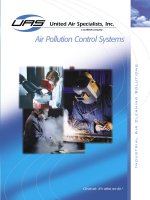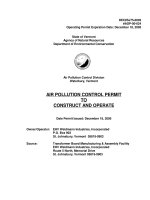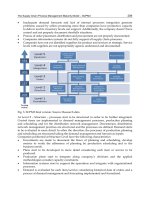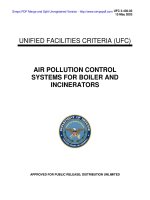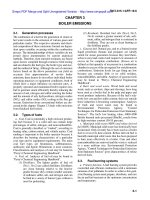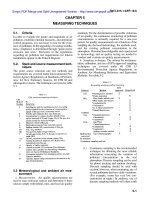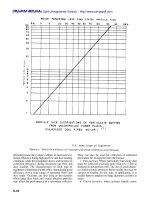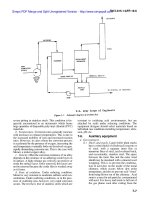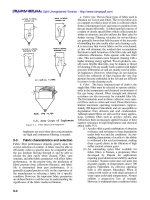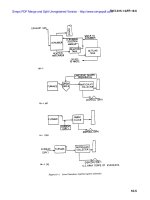Air Pollution Control Systems for Boiler and Incinerators Part 12 ppsx
Bạn đang xem bản rút gọn của tài liệu. Xem và tải ngay bản đầy đủ của tài liệu tại đây (51.05 KB, 10 trang )
TM 5-815-1/AFR 19-6
13-8
13-4. Fluidized bed performance predicted nitrogen oxide emissions.
a. With the exception of a baghouse or precipitator,
which is required for particulate removal, additional
gas cleaning devices are not required for environmental
control with fluidized bed systems.
b. Fluidized bed boilers are able to remove sulfur
dioxide directly in the combustor. This is accomplished
by using limestone in the fluid bed. The limestone The materials used for construction of fluidized bed
calcines to form calcium oxide (CaO) and then reacts units are similar to those used in conventional boilers
with SO to form calcium sulfate as follows: depending on the design pressure and temperature of
2
The ideal temperature range for desulfurization in a erosion than the horizontal ones. Where in-bed tubes
fluidized bed is about 1600 degrees Fahrenheit. are used, consideration should be given to use of
c. A bubbling fluidized bed boiler will require a thicker walls on the tubes and their metallurgy. Wear
higher calcium to sulfur ratio for control of SO , while fins can be installed to reduce erosion. Also, some
2
the circulating fluidized bed boiler can achieve similar corrosion may be experienced due to the reducing
SO removal with the Ca/S ratio of 1.5 to 2. See figure atmosphere in the lower regions.
2
13-8. b. Fluidized bed. The fluidized bed or bottom of the
d. Nitrogen oxide is controlled by distribution of combustor section varies considerably with each type
primary air under the bed and secondary air part way of design. The method used for air distribution is
up the combustor. The staging of combustion limits the important in maintaining uniform fluidization across
nitrogen oxide to that which is formed only by fuel- the bed. Some units have had problems with plugging
bound nitrogen. Thermally formed nitrogen oxide is of the air openings. The bottom is castable refractory-
negligible in the fluidized bed. See figure 13-9 for lined on some units. Others have heat transfer tubes
e. Several fluidized bed boiler manufacturers are
now offering performance guarantees based upon
experience in the bubbling, circulating, and dual bed
designs.
13-5. Materials and construction
the system.
a. In-bed tubes. The fluidized bed boilers that have
in-bed tubes have experienced high erosion rates in
some cases. Vertically oriented tubes are less prone to
TM 5-815-1/AFR 19-6
13-9
protected with abrasion resistant refractory in regions
where the gas flow changes directions.
c. Cyclone. In the circulating fluidized bed unit, the
cyclone separator is lined with refractory to minimize
abrasion and prevent heat losses.
d. Ash cooler. The ash cooler is also refractory lined
to increase life of the unit due to abrasion of the solids
being handled.
13-6. Auxiliary equipment
a. The following briefly describes the major compo-
nents of auxiliary equipment for the fluidized bed
boilers.
(1) Materials handling for fuel and limestone.
The handling of fuel and limestone will vary
depending on the source of supply and the
type of delivery. Delivery is usually by truck
or rail car.
(2) The conveying systems for the fuel and lime-
stone can be either a pneumatic or a mechan-
ical system. The mechanical system may be
belt, chain, bucket, or screw conveyor, or a
combination of these.
(3) Coal can be stored in open piles or storage
silos. From storage, coal is fed to a crusher or
dryer as required for efficient burning. Crush-
ing of the coal is required when it is run-of-
mine, for efficient burning, elimination of
rocks in the bed, high moisture content, high
ash content and when pneumatic conveying is
necessary.
(4) Drying of the coal is recommended when the
fuel moisture content exceeds fifteen percent
for all fluidized bed boilers except the
circulating fluidized bed boiler. The flue gas
from the fluidized bed can be used for drying
the fuel.
b. Coal feed stream slitter. The dual bed unit has a
proprietary stream slitter which permits accurate feed
of coal to multipoints under the bed for maximum
combustion efficiency.
TM 5-815-1/AFR 19-6
13-10
c. Startup burners. Startup burners are supplied in and changing of the primary to secondary air
the bed or air ducts to heat the bed up to coal ignition ratio
temperature. The startup burner can be used for low (3) Only fuel bound nitrogen converted to NO
loads. Usually it is capable of carrying about 20 percent (thermally formed NO is negligible)
or more of boiler capacity. (4) High combustion efficiency, (as high as 99
d. Fluidized bed heat exchanger. The fluid bed heat plus percent)
exchanger is used to cool the ash to about 750 degrees (5) High turn-down and load following ability
Fahrenheit. The coolant can be feedwater or any pro- (6) Uses a variety of fuels including:
cess fluid which requires heating. The metallurgy of the — high sulfur
heat exchanger must be compatible with the fluids it is — low BTU
handling. — high ash
e. Flue gas clean-up for particulate. Either an elec- — low cost
trostatic precipitator or a baghouse may be used for — waste materials
particulate control. Basic guidelines established for (7) High boiler efficiency (85 to 90 plus percent)
determining which type unit to use on a conventional (8) Load changes greater than 5% per minute
coal fired unit may be used to select the particulate (9) No retractable sootblowers. Rotary
control device for a fluidized bed boiler. Electrostatic sootblower may be used
precipitators can encounter resistivity problems (10) No slagging of coal ash
because of the low sulfur content in the particulate to (11) Low maintenance
be collected. (12) Dry ash
f. Ash-handling systems. (13) Broad tolerance to changes in coal quality
(1) The ash-handling systems are similar to ash- (14) Sulfur removal w/o need for scrubbers
handling systems for conventional boilers. b. Disadvantages:
The bottom ash does have to be cooled prior (1) Bed turn-down capability not clear
to disposal. Most of the ash-handling systems ` (2) Startup procedures more complex
are dry, and the ash can be sold for use in (3) Control response almost instantaneous
other products. (4) Use of partial bed slumping as load control
(2) Some potential uses of the ash are: aggregate mechanism for bubbling bed
in concrete; road base ingredients; stabiliza- (5) Requirement of a free-board for combustion
tion of soil embankments; pozzolan in efficiency for bubbling bed
masonry units and mortar; agriculture and (6) Corrosion susceptibility in bubbling bed
livestock feeds extender; and neutralization of (7) Calcium-to-sulfur ratio greater than 2.5
spent acid wastes. causes degradation of boiler efficiency
13-7. Advantages and disadvantages ventional boilers
a. Advantage:
(1) Low SO emissions
2
(2) Low NO emission due to staged combustion
x
x
x
(8) Fluidized bed is a newer technology than con-
(9) Complex under-bed fuel-feed system required
for some bubbling beds
TM 5-815-1/AFR 19-6
A-1
APPENDIX A
REFERENCES
Government Publications.
Department of Defense (DOD)
DOD 4270. 1-M Construction Criteria Manual
Departments of Army, Air Force, and Navy
AR 11-28 Economic Analysis and Program Evaluations for Resource
Management
AR 420-49/AFR 178-1 Facilities Engineering - Heating, Energy Selection and Fuel
Storage, Distribution and Dispensing Systems
NAVFAC P-422 Economic Analysis Handbook
Executive Department, The White House, Washington, D.C. Excecutive Order No.12003
(July 1977) Relating to Energy Policy and Conservation.
Envrionmental Protection Agency (EPA), 401 M Street SW, Washington D.C. 20005
AP 42 (May 1983) Compilation of Air Pollutant Emission Factors
EPA45O/3-81-005 (Sept.1982) Control Techniques for Particulate Emissions from
Stationary Sources
Government Printing Office, N. Capital Street, NW, Washington, D.C. 20001
Part 50, Title 40, Code of Federal Regulations Environmental Protection Agency Regulations on National
Primary and Secondary Ambient Air Quality Standards
Part 60, Title 40, Code of Federal Regulations Environmental Protection Agency Regulations on Standards
of Performance for New Stationary Sources
Part 53, Title 40, Code of Federal Regulations Environmental Protection Agency Regulations on Ambient
Air Monitoring Reference and Equivalent Methods
Nongovernment Publications
TAPPI Journal, Technical Association of the Pulp and Paper Industry, P.O. Box 105113, Atlanta, GA. 30348
Dec.1982, (pp.53-56). Fluidized Bed Steam Generation - An Update, by I.G. Lutes.
McGraw Hill Publishing Company, 1221 Avenue of the Americas, New York, New York 10001
Fifth Edition (1973) Perry’s Chemical Engineering Handbook by R.H. Perry.
Addison-Wesley Publishing Company, Inc., Jacob Way, Redding, Massachusetts 01867
(1963) Industrial Electrostatic Precipitators by Harry J. White
Air Pollution Control Association, P.O. Box 2861, Pittsburgh, Pennsylvania 15236
APCA #69-162 (1969) The Effect of Common Variables on Cyclone Performance
by J.W. Schindeler.
John Wiley & Sons 605 Third Avenue, New York, New York 10158
Fourth Edition (1964) Principles of Engineering Economy by E.L. Grant, W.G.
Ireson
Foster Wheeler Energy Corporation, 110 South Orange Avenue, Livingston, New Jersey 07039
(1979) The Technology and Economics of Fluidized Bed
Combustion
Combustion Engineering, Inc., 1000 Prospect Hill Road, Windsor; Connecticut 06095
TIS-7537 (1984) Circulating Fluid Bed Steam Generation by L. Capuano, K.
Ataby, S.A. Fox
TM 5-815-1/AFR 19-6
Glossary-1
GLOSSARY
Acid Dew Point Temperature at which acid vapor condenses to form acid droplets.
Actual Combustion Air The total amount of air supplied for complete combustion and equal to the
theoretical plus the excess air.
Air Register A type of burner mounting which admits secondary air to the combustion
area.
Air-to-Cloth Ratio The rate of volumetric capacity of a fabric filter (volume of air or gas in
ft /min per ft of filter fabric) commonly expressed as ft/min. Also called
3 2
filtering velocity, superficial face velocity, and filtration rate.
API Scale adopted by the American Petroleum Institute to indicate the specific
o
gravity of a fluid. (API gravity for a liquid rises as its temperature rises.)
Ash Non-combustible mineral matter which remains after a fuel is burned.
Atmospheric Stability Degree of non-turbulence in the lower atmosphere.
Atomization The breaking of a liquid into a multitude of tiny droplets.
Blinding (blinded) Loading or accumulation of filter cake to the point where the capacity rate
is diminished. Also termed "plugging" (Plugged).
Boiler (thermal) Efficiency Ratio of useful heat in delivered steam to the theoretical gross heat in the
fuel supplied.
Burner A device which positions a flame in a desired location by delivering fuel
(and sometimes air) to that location. Some burners may also atomize the
fuel, and some mix the fuel and air.
Calcine To render a substance friable by the expulsion of its volatile content through
heat.
Cloth Area The total amount of cloth area in the form of bags or envelopes in a fabric
filter system.
Cloth Weight A measure of filter fabric density. It is usually expressed in ounces per
square yard or ounces per square foot.
Co-Current Scrubbing spray liquid and exhaust gas flowing in the same direction.
Combustion Air Windbox Inlet plenum for preheated combustion air.
Combustion Efficiency The actual combustion heat released divided by the maximum possible heat
that can be released by combustion of a fuel.
Continuous Automatic Filtering A fabric filter unit that operates continuously, without interruption for
System cleaning. The flow pattern through the system is relatively constant.
Critical Temperature Temperature above which the substance has no liquid-vapor transition.
Dilution Air The air added downstream of the combustion chambers in order to lower
the exhaust gas temperature (In incinerators).
Entrainment Spray Atomized liquid downstream of scrubber spray nozzles.
ESP Electrostatic precipitator.
Excess Air The air remaining after a fuel has been completely burned (also, that air
which is supplied in addition to the theoretical quantity required).
Felted Fabrics Structures built up by the interlocking action of the fibers themselves,
without spinning, weaving, or knitting.
Filament A continuous fiber element.
Flue Gas All gases which leave the furnace by way of the flue, including gaseous
products of combustion and water vapor; excess oxygen and nitrogen.
TM 5-815-1/AFR 19-6
Glossary-2
Fly Ash Suspended particles, charred paper, dust, soot, or other partially burned
matter; carried in the gaseous by-products of combustion. (Sometimes
referred to as particulate matter, or pollutants).
Gas Absorption A process for removing a gas constituent from an exhaust gas stream by
chemical reaction between the constituent to be removed and a scrubbing
liquor.
Grain Unit of weight, equal to 1 lb.
7000
Heat Content The sum total of latent and sensible heat stored in a substance minus that
contained at an arbitrary set of conditions chosen as the base or zero point.
Usually expressed as Btu/lb, Btu/gal, Btu/ft for solid, liquid and gaseous
3
fuels, respectively.
Heat Release Rate (firing rate) The amount of heat liberated during the process of complete combustion
and expressed in Btu/hr/ft of internal furnace volume.
3
High Temperature Fixation Reaction between nitrogen and oxygen at a high temperature in air
Reaction forming nitrogen oxides.
Horizontal Front Wall Firing Horizontal furnace firing with all burners located in the front wall.
Horizontal Opposed Firing Horizontal furnace firing with burners located on directly opposing walls.
Impaction Particle to liquid adherence from collision.
Intermittent Filtering System A flow pattern in a fabric filter system which is saw-tooth-like. The flow
continually decreases until it is stopped. Then cleaning takes place and flow
is then again resumed at an increased value which again decreases, etc.
In. Water Inches of water column used in measuring pressure. One inch of water
column equals a pressure of .036 lb/in .
2
Mass Transport Any process or force that causes a mass to flow through an open system.
Micron Unit of length, equal to 1 millionth of a meter.
Multiple Chamber In-Line An incinerator design that allows combustion gases to flow straight through
the incinerator with 90-degree turns in only the vertical direction.
Multiple Chamber Retort An incinerator design that causes combustion gases to flow through 90-
degree turns in both horizontal and vertical directions.
Mulicompartment Baghouse A compartmented filter baghouse that permits a uniform gas flow pattern
as compartments are taken offline for cleaning.
NO Nitrogen oxides.
x
Overfire Air (Secondary Air) Any air controlled with respect to quantity and direction, which is sup-plied
beyond the fuel bed (as through ports in the walls of the primary combustion
chamber) for the purpose of completing combustion of materials in gases
from the fuel bed. (Also used to reduce operating temperatures within the
furnace and referred to as secondary air).
Orsat Analysis An apparatus used to determine the percentages (by volume) of CO , O ,
2 2
and CO in flue gases.
Permeability (of fabric) The ability of air (gas) to pass through filter fabric, expressed in ft of air per
3
mm. per ft of fabric with .5" H O pressure differential.
2
2
Peak Flame Temperature The highest temperature achieved in the primary combustion zone.
Plant Thermal Efficiency The actual power output of a plant divided by the theoretical heat input rate.
Plenum (or Plenum Chamber) Part of a piping or duct flow system having a cross-sectional area consider-
ably larger than that of any connecting ducts pipes or openings.
Porosity (Fabric) A term often used interchangeably with permeability. (Actually a percentage
of voids per unit volume).
Preheated Air Air heated prior to its use for combustion, frequently by hot flue gases.
Primary Combustion Temperature Temperature measured at the flame.
TM 5-815-1/AFR 19-6
Glossary-3
Reentrainment (re-entrainment) Particles reentering the gas stream after having been captured in a
particulate collection device.
Residual Dust Accumulation The fairly stable matrix of dust that remains in a woven fabric after it is
cleaned. It accounts for the relatively high collection efficiency of a woven
fabric immediately after cleaning.
Tangential Firing Four-cornered fuel firing to create a swirling flame pattern in a furnace.
Theoretical Air The exact amount of air required to supply oxygen for complete combustion
of a given quantity of a specific fuel.
Theoretical Flame Temperature The maximum possible flame temperature from burning a fuel.
Thread Count The number of warp and filling yarns per inch in woven cloth.
Underfire Air Any air controlled with respect to quantity and direction, forced or induced
and supplied beneath the grate, that passes through the fuel bed.
Volume Flow Rate The quantity (measured in units of volume) of a fluid flowing per unit of
time, as ft /min or gal/hr.
3
Woven Fabric Fabric produced by interlacing strands at approximate right angles.
Lengthwise strands are called warp yarns and cross-wise strands are called
filling yarns.
LIST OF ABBREVIATIONS USED IN THIS MANUAL
Actual Cubic Feet per Minute (ACFM)
Best Available Control Technology (BACT)
British Thermal Units per Hour (Btu/hr)
Carbon Dioxide (CO )
2
Carbon Monoxide (CO)
Cubic Feet per Minute (CFM)
Degrees Fahrenheit (Deg F)
Department of Defense (DOD)
Dry Standard Cubic Feet per Minute (DSCFM)
Electrostatic Precipitators (E SP's)
Feet per Minute (Ft/Mm)
Feet per Second (Ft/Sec)
Flue Gas Desulfurization (FGD)
Grains per Cubic Foot (Gr/Ft )
3
Grains per Square Meter (Gr/M )
2
Grains per Standard Cubic Foot (Gr/
Std. Ft )
3
Micro-grams per Cubic Meter (Ug/M )
3
Mili-amperes (mA)
Million British Thermal Units 1) (Mu Btu)
2) (MM Btu)
Municipal Solid Waste (MSW)
Month (Mo)
National Ambient Air Quality Standards (NAAQs)
Navy Energy and Environmental Support Activity (NEESA)
New Source Review (NSR)
New Source Performance Standards (NSPS)
Nitrogen Dioxide (NO )
2
Nitric Oxide (NO)
Nitrogen Oxides (NO )
x
TM 5-815-1/AFR 19-6
Glossary-4
Non-attainment (in conjunction w/PSD) (NA)
Ozone (O )
3
Percent (%)
Pound (lb)
Pounds per Square Inch (Lb/in )
2
Prevention of Significant Deterioration (PSD)
Refuse Derived Fuels (RDF)
Square Feet (Ft )
2
Square Meter (m )
2
Sulfur Dioxide (SO )
2
Sulfur Oxides (SO )
x
Sulfur Trioxide (SO )
3
U.S. Environmental Protection Agency 1) (USEPA)
2) (EPA)
U.S. Army Environmental Hygiene Agency (USAEHA)
Year (Yr)
TM 5-815-1/AFR 19-6
Biblio-1
BIBLIOGRAPHY
"Coal Cleaning to Improve Boiler Performance and Reduce SO Emissions," Power; Sept.1981.
2
"Combustion-Fossil Power Systems", Combustion Engineering Co., Inc., 1981.
"Fuel Flexibility High on List of Design Objectives for New Station," Power; May 1982.
Kelly, A.J., and Oakes, E., Pyropower Corporation, "Circulating Fluidized Bed Combustion Systems and Commer-
cial Operating Experience," 1982 TAPPI Engineering Conference, San Francisco, CA.
Kelly, W.R., J.M. Rourke, and Mullin, D.E., "Industrial Application of Fluidized-Bed Cogeneration System."
Chemical Engineering Progress, January 1984.
Lund, T., Lurgi Corporation, "Lurgi Circulating Bed Boiler: Its Design and Operation," Seventh International
Conference on Fluidized Bed Combustion, Philadelphia, PA. 1982.
"Pollution Control," Power; April 1982.
Ramsdell, Roger G., "Practical Design Parameters for Hot and Cold Precipitators," Paper presented at the
American Power Conference, Chicago, Illinois, May 1973.
Schwieger; R. and J., "Special Report - Fluidized Bed Boilers", Power, August 1982, S1-S16.
Smith, J.W., Babcock & Wilcox, 'AFBC Boiler Development Accomplishments and Requirements. " 1982 TAPPI
Engineering Conference, San Francisco, CA.
Steam-Its Generation and Use, 38th edition, Babcock and Wilcox, 1972.
Yip, H. H. and Engstrom, F., Pyropower Corporation and Ahlstrom Company, "Operating Experience of Commer-
cial Scale Pyroflow Circulating Fluidized Bed Combustion Boilers." Seventh International Conference On
Fluidized Bed Combustion, Philadelphia, PA. 1983.
The proponent agency of this publication is the Office of the Chief of Engineers, United States Army.
Users are invited to send comments and suggested improvements on DA Form 2028 (Recommended
Changes to Publications and Blank Forms) direct to HQ USACE (CEEC-EE), WASH., DC 20314-1000.
By Order of the Secretaries of the Army and the Air Force:
CARL E. VUONO
General, United States Army
Official: Chief of Staff
R.L. DILWORTH
Brigadier General, United States Army
The Adjutant General
Larry D. Welch, General, USAF
Official: Chief of Staff
William 0. NATIONS, Colonel, USAF
Director of Information Management
and Administration
Distribution:
Army: To be distributed in accordance with DA Form 12-34B, requirements for Energy Monitoring and
Control Systems (EMCS).
Air Force: F
